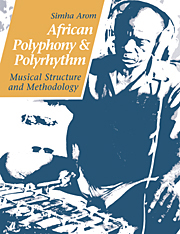Book contents
- Frontmatter
- Contents
- List of illustrations
- Foreword by György Ligeti
- Preface
- Acknowledgements
- BOOK I THE MUSIC OF THE CENTRAL AFRICAN REPUBLIC
- BOOK II AFRICAN POLYPHONIC MUSIC
- BOOK III TECHNICAL TOOLS: METHODS OF RECORDING POLYPHONIC MUSIC FOR TRANSCRIPTION
- BOOK IV THEORETICAL TOOLS
- BOOK V THE ORGANISATION OF TIME IN AFRICAN MUSIC
- BOOK VI STRUCTURAL PRINCIPLES AND THEIR APPLICATION
- 1 Typology
- 2 Analytical notions
- 3 Strict polyrhythmics
- 4 Polyrhythmics as a way to polyphony: Hocket
- 5 Polyphony produced by melodic instruments
- 6 The association of polyphony and polyrhythmics
- Conclusion
- Bibliography
4 - Polyrhythmics as a way to polyphony: Hocket
Published online by Cambridge University Press: 27 January 2010
- Frontmatter
- Contents
- List of illustrations
- Foreword by György Ligeti
- Preface
- Acknowledgements
- BOOK I THE MUSIC OF THE CENTRAL AFRICAN REPUBLIC
- BOOK II AFRICAN POLYPHONIC MUSIC
- BOOK III TECHNICAL TOOLS: METHODS OF RECORDING POLYPHONIC MUSIC FOR TRANSCRIPTION
- BOOK IV THEORETICAL TOOLS
- BOOK V THE ORGANISATION OF TIME IN AFRICAN MUSIC
- BOOK VI STRUCTURAL PRINCIPLES AND THEIR APPLICATION
- 1 Typology
- 2 Analytical notions
- 3 Strict polyrhythmics
- 4 Polyrhythmics as a way to polyphony: Hocket
- 5 Polyphony produced by melodic instruments
- 6 The association of polyphony and polyrhythmics
- Conclusion
- Bibliography
Summary
DEFINITION AND GENERAL CHARACTERISTICS
Definition
Polyphony by way of polyrhythmics, or hocket, is created by the interweaving, overlapping, and interlocking of several rhythmic figures located on different pitch levels in a specific scalar system.
General characteristics
In Subsaharan Africa, the hocket technique is utilised by ensembles of wind instruments. All the instruments in the ensemble are invariably of the same type (horns or whistles), but of different size. Their pitches are assigned according to a predetermined scale. The number of instruments in the ensemble may vary from five to twenty. Each emits a single pitch chosen from among the degrees of the scale. The factor of melody thus only comes into play at the level of the whole ensemble, as each individual instrument is confined to performing a rhythmic figure, which is inseparable from a predetermined pitch level.
Each musician is assigned his own rhythmic figure for each of the pieces in the repertory of the ensemble. In some cases, this figure allows variations. The fact that these figures are meshed and tiered at different fixed pitches within a predetermined scale results in a very strict type of hocket which stands precisely at the boundary between strict polyrhythmics and polyphony. This is an extremely widespread technique in Africa, which can be found in the west (Cameroon), centre (Congo, Zaïre, Central African Republic), east/northeast (Kenya, Uganda, Ethiopia), and south (South Africa).
In the Central African Republic, only the Dakpa and Linda peoples, who belong to the wider Banda ethnic group, seem to use this kind of hocket. Specific repertories employing it are provided for horn ensembles in both communities.
- Type
- Chapter
- Information
- African Polyphony and PolyrhythmMusical Structure and Methodology, pp. 307 - 504Publisher: Cambridge University PressPrint publication year: 1991



